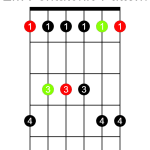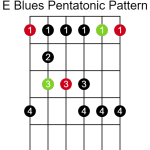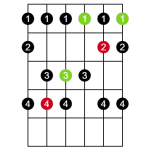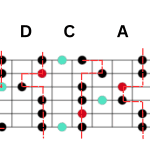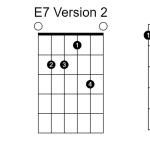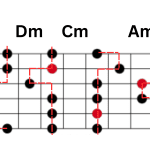Although I encourage beginners to simply learn the minor pentatonic scale shapes on guitar, this method doesn’t work for everybody. Some players like to see where they can play a scale for a given key everywhere on the guitar. Because of this, this lesson will outline everywhere you can play an A minor pentatonic scale on guitar. If you had trouble just learning the shapes and finding the right root notes on the guitar, this is the article for you! I’ll go through each position where you can play an A minor scale, and before you know it you’ll be jamming away.
Get your head around playing the A minor pentatonic scale and then go back to the article with the general shapes and try to expand that knowledge into different keys. If you’re still having trouble, check out my other lessons on playing pentatonic scales in other keys until you start to see the pattern.
What Notes Are In The A Minor Pentatonic Scale?
A pentatonic scale is made up of five notes (“penta” means five and “tonic” means note), so five notes. Every minor pentatonic scale is made up of the 1st, 3rd (which is minor because it’s a minor scale), 4th, 5th, and 7th (which is flat because it’s a minor scale) notes of the minor scale. In a minor pentatonic scale, you’re not playing the 2nd and 6th degree of the scale.
So here, you’re just playing 1, b3, 4, 5, b7.
The corresponding notes for the A minor pentatonic are A, C, D, E, and G.
How To Play The A Minor Pentatonic Scale In Different Fret Positions
There are five main positions you can play the A minor pentatonic scale across the fret board before getting up to the 12th fret of the guitar and simply starting again. Each position is described by the fret that your first finger (your index finger) is on.
So, for example, fifth position means that your first finger is on the fifth fret.
The only exception to this is open position, which can easily be confused with first position. In open position you’re playing open strings and are likely using your first finger on the first fret. Meanwhile, in first position, you’re not playing open strings. That’s kind of a blunt way of putting it, but it’s the simplest explanation for this lesson.
Playing An A Minor Pentatonic Scale In Open Position


In the diagram here, I’ve marked the root notes on the fretted strings, but each string is also played open. So, for example, starting on the fifth string, you pluck it open, then the 3rd fret of the fifth string, open fourth string, and so on.
A lot of new players like to jump up the fret board and not play a scale in open position. While that’s great for better understanding the shapes, don’t discount open scales! These can sound great in any genre, especially in Country and Rock.
Playing An A Minor Pentatonic Scale In Second Position


Here, you’re playing the scale in a “G shape” because it corresponds to a G chord. While you may want to think of this as fifth position because the lowest root note is on the 5th fret of the fifth string, you’re in second position because of where your index finger is. Get it?
This shape can be a little uncomfortable at first and can be a bit of a stretch in the second position. Play it slowly and get familiar with it. If you’re having trouble, move up to playing the A minor pentatonic scale in the fifth position as it’s a little more natural for beginners. Once you get your fingers moving you can come back to this one.
Playing An A Minor Pentatonic Scale In Fifth Position


Playing an A minor pentatonic scale in the fifth position is in the “E shape” as it corresponds to the open chords. Can you see the E minor barre chord inside the scale?
Personally, I like the E shape pentatonic scale and I love it on the fifth fret. This is where I first started learning pentatonic scales and usually where I suggest people start. The pattern for the scale in this shape tends to be the easiest for people to play, and fifth position is a good balance between not being to wide between the frets and not too narrow.
If you’ve had trouble with the other pentatonic scale shapes, start right here. Play the pattern up and down, get your fingers moving, and you’ll develop quite quickly.
Playing An A Minor Pentatonic Scale In 7th Position


This shape isn’t terribly difficult but can tangle the fingers up somewhat, at least in my experience when I was first learning pentatonic scales.
Play the scale slowly until you’re able to play it cleanly. Over time you can speed up as you get more comfortable. The only way to get faster is through repetition and muscle memory.
Playing An A Minor Pentatonic Scale In Ninth Position


This minor pentatonic scale pattern is based on the C shape chord.
This final position can be a little tricky because it spans five frets rather than four like the other pentatonic scale shapes. As per the diagram, note that you have to shift your first finger up a fret when you move to the second string. However, once you you get the hang of the shift, this can be a really fun pentatonic scale shape to play and get you used to general position changes for the future.
Have fun.
Connecting The A Minor Pentatonic Scale Shapes
From here you can play the A minor pentatonic scale in different positions across the guitar neck, but what if you want to shift from one position to another? It’s easy.
Firstly, I encourage you to read my lesson on connecting minor pentatonic scale patterns across the guitar neck. This lesson outlines how the shapes are connected for every shape.
Just remember, starting with the open shape, the pentatonic scale patterns you’re playing are Am, Gm, Em, Dm, then Cm. As long as you know where your root notes are, you can easily shift from shape to shape. Check out the diagram below with root notes marked in red.


And that’s the A minor pentatonic scale!
I’ve written this at a beginner level with an effort to not overwhelm readers with too much information. Get comfortable here and, once you are, take a look at the other lessons I’ve linked that outline the more general pentatonic scale shapes as well as generally connecting of pentatonic scales across the fretboard. If you can understand those more complex lessons, you can then apply what you’ve learned to any key.
Related posts:
